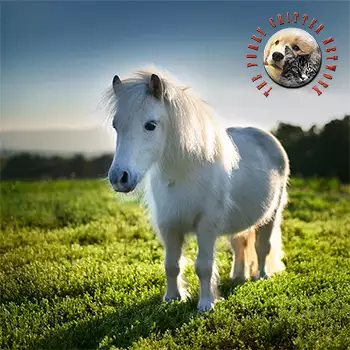History
The American Miniature Horse is a unique breed, the limiting characteristic of which is size. It must not measure in excess of 34 inches in height, which is measured at the withers, at the last hairs of the mane. It must be a sound, well-balanced horse, possessing the proper conformation characteristics which are common to most of the larger breeds. In fact, if there were no size reference, the miniature horse might give the illusion of being a full-sized horse. The American Miniature Horse gives the impression of strength, agility, and alert intelligence and is available in all possible colors.
The American Miniature Horse extracted from many sources in the creation of the breed. Undeniably, it utilized the blood of the English and Dutch mine horses, that were brought to this country in the 19th century and were used in some Appalachian coal mines as late as 1950. It also drew upon the blood of the Shetland pony, several of which appear in the pedigrees of some miniatures today. In the past decade, several breeders have imported miniature horses from England, Holland, Belgium, and West Germany, while others have selectively bred miniatures from the larger breeds of horses.
In 1978, The American Miniature Horse Association (AMHA) was formed. It is now the only registry in existence that deals exclusively with true Miniatures, 34 inches and under. Ponies over 34 inches are not considered Miniatures; they were not in the beginning, and they are not today (excluding the AMHR miniatures that measure 38 inches and under).
The American Miniature Horse as a breed is currently being standardized. The American Miniature Horse Association was organized and incorporated in July of 1978 to maintain a registry and stud-book. A Standard of Perfection was adopted in 1978 and that two basic body types, a "draft" type and a fine-boned "refined" type, were present in the existing foundation stock, the Standard called for a blending of types into an elegant little horse.
Behavior
Miniature horses are generally bred to be friendly and to interact well with people. For this reason they are often kept as family pets, though they still retain natural horse behavior, including a natural fight or flight instinct, and must be treated like an equine, even if they primarily serve as a companion animal. They are also trained as service animals, akin to assistance dogs for people with disabilities. Miniature horses are also trained for driving, equine agility, and other competitive horse show type events.
Function
There is controversy over whether miniature horses are suitable as assistance animals for persons with disabilities. Those who favor their use point out that horses live much longer than dogs and can be trained to perform similar tasks. Another plus is that some individuals, particularly from Muslim cultures, consider dogs unclean, but accept horses.
Opponents of their use raise concerns that miniature horses are prey animals, with a fight-or-flight instinct that may limit their usefulness, and for legal reasons. In the US, where they are legally classified as livestock and require outdoor stabling for good health, their use is limited to owners with access to a large yard in communities having tolerant land use regulations. In terms of practical considerations, they note that it is difficult for even a miniature horse to do things such as lie down in the seat of a taxicab or to stay in a hotel room for extended periods of time.
Health
Generally quite hardy, often living longer on average than some full-sized horse breeds; the average life span of miniature horses is from 25 to 35 years.
Dwarfism is a concern within the miniature horse world. Dwarf horses, while often setting world records for size, are not considered to have desirable traits, generally have incorrect conformation, and may have significant health and soundness issues. Therefore, many miniature horse registries try to avoid accepting minis affected by dwarfism for breeding stock registration. In 2014, a commercial DNA test became available for one set of dwarfism mutations. The four mutations of the ACAN gene are known to cause dwarfism or aborted fetuses in miniature horses. The test does not detect the mutations that cause skeletal atavism in miniature horses and some ponies, or the osteochondrodysplasia dwarfism seen in some horse breeds.






